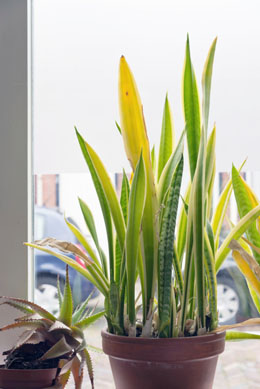A native to the tropical regions of West Africa, the snake plant is considered as one of the toughest houseplants. Let's get to know about the different features it exhibits and the requirements for its healthy growth.

Scientifically known as
Sanseveria trifasciata, this variety is known to withstand all types of conditions and thus makes it ideal for beginners or novices. The leaves are heavy and have an appearance similar to that of a sword. These leaves have an architectural built, which are upright and can grow up to 3 or 4 feet tall. The fiber of this plant was once used to make bowstrings. However, it is now used as an ornamental and as an indoor plant in cooler climates. As a house plant, it improves indoor air quality by getting rid of toxins such as nitrogen oxide and formaldehyde.
Caring Instructions
The snake plant, according to what many hobbyists have experienced, can grow even when deprived of light for weeks. However, it is said to prefer moderate to bright light and it can also adapt to full sun. Loose, well-drained potting mix is good enough for its growth. It can also adjust to sandier soil. Watering once every 7-10 is generally enough. The soil should be allowed to dry between watering. During winter, reduce the watering sessions to once in a month.
Under-watering and over-watering are the only things which can kill this plant. You will understand if you are over-watering the plant, when the foliage begins to droop and in case if the plant is not receiving enough water, its foliage will begin to wrinkle and bend over.
This variety fancies warmth, and hence, temperature below 50 degree Fahrenheit (10 degree Celsius) may be harmful for its health. It is advisable to grow it in a pot. Repotting may be considered only when the pot becomes too small to maintain an upright position. Fertilizer that is suitable during the growing season is mild cactus fertilizer. There is no need to fertilize it during winter.
Propagating the plant is simple and can be done by propagating a healthy green leaf of the plant itself. Make some cuttings of the leaf into 3-4 inch segments and plant them in a fresh potting soil. Make sure that you pay attention to the top and bottom portion of the cuttings, before planting them. Once planted, keep them in a bright and warm place, avoiding direct sunlight. Water the soil to make it moist, not soggy. 3-4 weeks is the period which is required for the cuttings to grow its roots and a couple of months for the leaves. The propagation can also be done by potting new shoots which emerge from the soil as spikes. As an alternative, the plant can also be divided during repotting.
'Compacta', 'Silver Hahnii' and 'Silebersee' are some of the many popular snake plant varieties, or also known as cultivars (a variety of a plant developed from a natural species and maintained under cultivation). Other varieties include 'Goldiana', 'Hahnii' and 'Laurentii'.
It is advisable to keep it away from the reach of pets and children since it is considered to be poisonous if ingested.






 Scientifically known as Sanseveria trifasciata, this variety is known to withstand all types of conditions and thus makes it ideal for beginners or novices. The leaves are heavy and have an appearance similar to that of a sword. These leaves have an architectural built, which are upright and can grow up to 3 or 4 feet tall. The fiber of this plant was once used to make bowstrings. However, it is now used as an ornamental and as an indoor plant in cooler climates. As a house plant, it improves indoor air quality by getting rid of toxins such as nitrogen oxide and formaldehyde.
Scientifically known as Sanseveria trifasciata, this variety is known to withstand all types of conditions and thus makes it ideal for beginners or novices. The leaves are heavy and have an appearance similar to that of a sword. These leaves have an architectural built, which are upright and can grow up to 3 or 4 feet tall. The fiber of this plant was once used to make bowstrings. However, it is now used as an ornamental and as an indoor plant in cooler climates. As a house plant, it improves indoor air quality by getting rid of toxins such as nitrogen oxide and formaldehyde.